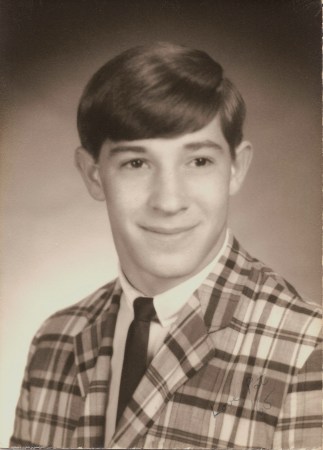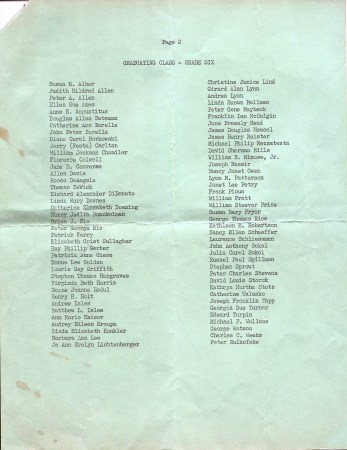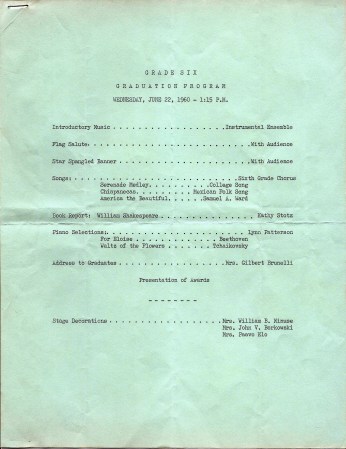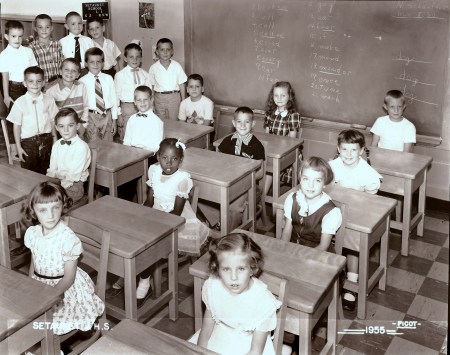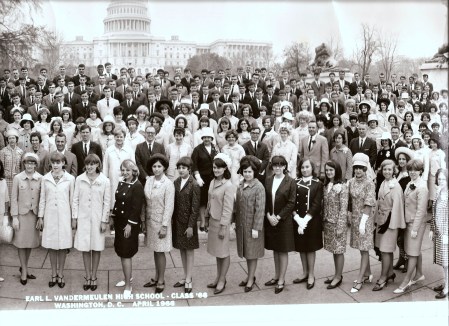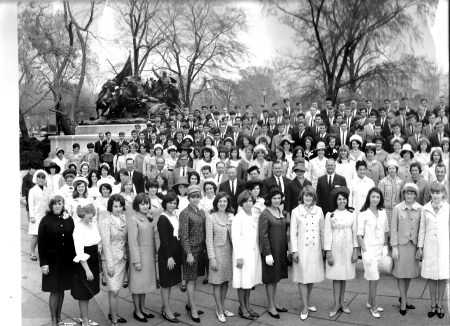Patrick Ferry:
CLASS OF 1966

Earl L. Vandermeulen High SchoolClass of 1966
Port jefferson, NY
Port Jefferson High SchoolClass of 1966
Port jefferson, NY
Gelinas Junior High SchoolClass of 1963
Setauket, NY
Setauket Elementary SchoolClass of 1960
Setauket, NY
Maplewood Elementary SchoolClass of 1954
Sylvania, OH
Patrick's Story
I am originally from southern Ohio. My first home was outside the small town of New Lexington. This area is best known for the ancient "Indian Mounds" which are abundant there. My great grandparents were coal miners on my mom's side of the family, and my grandmother and her sister worked at the Roseville Pottery, painting designs on the pottery before glazing. My dad's family were oil drillers in the Pennsylvania oil fields. My great grandfather McLain ran a blacksmith shop and livery stable in Emlenton, PA.
We moved to northern Ohio sometime before my fourth birthday. We lived in Sylvania, just west of Toledo near the Michigan border. Most of my memories from that area involve shooting marbles, playing in the crick with my friend Tim, and learning to ride a bicycle. I spent one year in the Maplewood Avenue Elementary School before we picked up and moved to Long Island, New York.
Setauket was still a small town when we arrived. The farms surrounding the town grew potatoes and cauliflower. We lived on West Meadow Road, and I spent the summers at the beach. Mrs. Murphy was the music teacher at Setauket Elementary School. She tried to give everyone the opportunity to play an instrument, and tried to teach us all to read music, a good thing. She also tried to teach us to sing the Setauket School song ... "Setauket here we are, working together"... yada yada, a bad thing, especially if you have a voice like mine (reminiscent of a punch drunk Irish boxer with poor diction).
Junior High School at Setauket, when Mr. Gelinas was the principal, and long before the school got it's new name. Mr. Ernst and Mr. Werner were the science teachers. Mr. Werner used to take the earth sciences classes out on field trips in the local area. We would study the rocks, and the soil, and usually he divided us into teams and we got to play "Steal the Flag" before heading back to class.
Mr. Rothstein was the English teacher. When I was in his classes I really hated him. He made us keep these detailed notebooks, outlines, he drilled us on spelling every week. God it was painful. It wasn't until I finally matured at about age 27 and was at Purdue University, that I figured out the value of the detailed notebooks and keeping outlines. I guess this is my only chance to pay a little homage to a very good teacher.
High School at Port Jeff was different. I found it too easy to disappear. The school year only existed to break up my summer vacations. All I wanted to do was go out on my boat and lay on the beach with my girlfriend. I spent most of the school day skipping classes, smoking cigarettes, and generally goofing off. Sadly I remained a boy in a man's body for far longer than most of the students. I carried my bad temper and immaturity for several years after graduating.
Pat Dunn and I joined the Navy on the delayed entry program. We both spent the summer working for the Davey Tree Company, spraying power right of ways throughout southern Massachusetts. The spray was a mixture of fuel oil and a chemical called 2-4-D. Wasn't until 20 years later that I learned that was the chemical name for Agent Orange. Pat and I practically swam in the stuff. We smelled so bad when we got back to our boarding house in the evenings, that the landlady made us change in the garage.
Later on we worked on Staten Island spraying a plastic sealant on telephone cables. We also climbed trees and cleared power lines along the road in Brewster, NY.
I started active duty before my 18th birthday. The plan was to do my three years and get out on my 21st birthday. Ended up staying in for 27+ years.
I had some great duty stations, and really got to travel. I spent four years in the Philippines, 4 years homeported with CTF 63 in Naples, Italy, plus an additional 4 years with NATO in Naples, 4 years in Australia, and rode just about every ship type the Navy had except for minesweepers and submarines. During my duty with NATO I got to spend a Mediterranean cruise onboard the French Aircraft Carrier FS Foch as Communications Liaison Officer, interesting duty, and the only time in my adult life when my high school French language studies ever came in handy.
My career included working the CW radio room at the Receiver Site at NavCommSta San Miguel Philippines when the distress call from the USS Forrestal came in on 500KHZ. The guys in that room worked with the Forrestal non-stop for nearly 24 hours just taking her casualty lists.
During my tour on the USS Ticonderoga, we were WestPac deployed to the Tonkin Gulf, when, on 15 April 1969, the North Koreans shot down a Navy EC-121 belonging to VQ-1 over international waters. All 31 crewmembers were killed, and only two bodies were ever recovered. We joined up with the USS Enterprise and several other carriers and support ships, eventually comprising the largest Naval Flotilla since WWII. We steamed around, freezing our butts off, and "making a Naval Demonstration". I'm really happy that the President got a feel good moment.
The strangest event I witnessed was in 1971 at Fleet Weather Facility Sangley Point, Philippines. We were preparing to close down the US base, and turn it over to the Philippine Marines. I guess some of the locals decided that they needed to act fast, so they loaded up a bread truck with men and guns, came through the front gate, and headed for the base bank. They took several hostages during the robbery. They killed one US Marine LT who was responding to the bank alarm. They escaped by driving down one of the base perimeter roads, cutting a hole in the fence line, leaving the truck behind. At least 4 of the accused in the robbery were members of the Cavite City police force.
Navy Astronautics Group in Point Mugu, California. I was first assigned as a watch stander in communications, then qualified as a Satellite Controller, and finally as Leading Radioman.
In 1974, while I was stationed at Navy Astronautics Group in Point Mugu, California, I was fortunate enough to be selected for the Navy Enlisted Scientific Education Program (NESEP). Many thanks to the Commanding Officer, Captain William Liebert. I attended college at Purdue University, earning a Bachelor of Science in Math (Mr. Maloney is probably writhing in pain at the thought), with a minor in history.
After graduation from Purdue, I was assigned to Surface Warfare Officer School in Coronado, California. In June 1978 I graduated from SWOS, and attended Counter Terrorism School, Operational Deception School, Remote Sensors school, Communications Jamming and Interference school, and Communications Officers School.
My tour on the USS Mount Vernon (LSD-39) was interesting from the first month I went aboard. I was just out of Surface Warfare Officer School, and Communication Officers School, when I reported aboard the ‘Mickey-Vee’.
I was informed by the XO that they didn't need a communicator, so I was being assigned as the Combat Information Center Officer. On WestPac in 1979-1980, we participated in Operation Kangaroo 3, a joint operation with the Australian and New Zealand Navies. The ‘Mickey Vee’ was assigned as the primary control ship for the amphibious phase of operations. After a successful operation we got to spend a week in Brisbane, Australia. That really whet my appetite to see more of Australia.
When the Iranians took over the American Embassy in Tehran, our Amphibious Ready Group received orders to deploy to the Indian Ocean in preparation for possible action against the Iranians. As with all things Jimmy Carter did, it was a...Expand for more
ll threat and no action. Our ARG steamed holes in the ocean for a couple weeks, then got orders to stand down. It did get us an extra long visit to Singapore though so it wasn’t all bad!
Before we could complete our deployment, we were sent to Eniwetok Atoll to participate in the radiological cleanup. America used the atoll to test the first hydrogen bomb in the fifties, in addition to about 42 other nuclear tests between 1948 and 1958. The boats from the ship would load the contaminated materials from the islands and deliver them to one of the bomb craters. The contaminated materials and debris were mixed with Portland cement and dumped into the crater. Then the materials were covered with an 18 inch thick concrete cap. The islands were declared fit for re-habitation in 1980.
In May 1980, we were headed into Portland, Oregon for a shipyard overhaul at the Willamette Shipyards. We were headed to the mouth of the Columbia River when Mount Saint Helens decided that it was time to go. The logs and debris (lahar) that came rushing down the Cowlitz River and into the Columbia River, closed the River to traffic for deep draft vessels. Mount Vernon and crew were then diverted to Seattle, where we spent a couple of weeks while the Army Corps of Engineers cleaned up and dredged the Columbia. There were several more eruptions on St Helens while we were tied up in Portland. The ash destroyed the engines of several crew member’s cars … and cleaning it off the decks of the ship was a nightmare. The stuff felt like it weighed about two pounds per square inch. It was easy to break a broom handle try to sweep the decks. We finished our overhaul in June 1981, and went back to our original home port of San Diego. I transferred in September 1981, but it was definitely a memorable tour.
I worked for CTF 63, homeported in Naples Italy from 1981-1985. While on staff with CTF 63 I had the opportunity to serve as 6th Fleet Fuels Officer, which meant I got to schedule the refueling for every ship in the Mediterranean theater. After that I was assigned as the Assistant Operations Officer for Task Force Scheduling.
The tour at CTF 63 was followed by NATO Staff duty with Commander Striking and Support Forces Southern Europe. at Bagnoli, Italy from 1985-1989. During those two tours of staff duty I rode the following ships for varying lengths of time (2 weeks to 6 months): USNS Saturn; USNS Sirius; USS Concord; USS Sylvania; USS Seattle; USS Dwight D. Eisenhower; USS John F. Kennedy; USS Belknap; USS Yellowstone; USS Wainwright; USS Milwaukee; USS Butte; USS Nitro; USS Puget Sound; USS Yosemite; USS Detroit; USS Monongahela; USNS Truckee; USNS Waccamaw; USNS Pawcatuck; USNS Neosho; USNS Kawishiwi; USS Niagra Falls; USS Kalamazoo; USS Comte De Grasse; USS Oliver Hazard Perry; USS Samuel Eliot Morrison; USS Tripoli; USS Dubuque; USS Denver; USS Coronado; and the FS Foch (French Aircraft carrier).
Then … the absolute best duty in the US Navy fell into my lap. I received orders to report to Naval Communication Station Harold E Holt in Exmouth, Australia. It was remote, it was hot, it was a challenge … and it was the most rewarding experience I have ever had. I was the Communications Officer, and collateral duty Executive Officer for the US personnel. The base was jointly manned by US Navy and the Royal Australian Navy. After four years, we finally had to leave, so my wife and I opted to drive from Northwest Cape to Sydney, then we flew to New Zealand for two weeks. We started out by driving Northeast along the north coast of Australia. We stopped in the Kimberly's and visited the Kimberly Diamond mines, then drove on to Broome, where we visited the pearling ships. We also drove to Derby, the Boab Prison Tree, Tunnel Creek Park and visited Windjana Gorge. Continuing East, we spent a day driving in to visit the Bungle-Bungles. The Bungle-Bungles is a very strange and beautiful landscape. Exploring it on foot was very difficult, and it's pretty easy to get lost. We also did a helicopter fly over. Gorgeous! Then there was a quick visit to the Wolf Creek Meteorite Crater National Park.
Next stop was Darwin, and Kakadu National Park. We had a couple of days there, but even that was far too short. We also took a cruise on the Adelaide River to see the "jumping crocodiles". If you take the cruise...keep your hands inside the rails of the boat. Next we headed south, and visited Alice Springs and Uluru - Kata Tjuta National Park where we climbed to the top of Ayers Rock.
As we continued South, we encountered the most unusual town I have ever seen, Coober Pedy. It is known as the Opal Capital of the World. Most of the town is underground, for several good reasons. The first reason is that it is a barren stretch of desert where daytime temperatures rapidly become unbearable. The second reason is that you stake a claim and begin digging. They have entire hotels and swimming pools located underground. The underground homes and hotels were originally where they were digging for the opals, and as they continued to dig, their homes grew larger. We bought several opals directly from the mines here.
On to the South we drove, finally spending a week with friends in the city of Adelaide. Then on to the Blue Mountains and Sydney. We had rented a loft apartment overlooking Darling Harbour, and spent the week walking the city.
My next, and final, duty station was at Naval Communications Station Newport, RI. I only spent a few months working there before the Navy told me I was getting old, and it was time to retire.
After retiring from the Navy, I started working at a residential treatment facility for "court adjudicated youth" who had drug involvement in their criminal behavior (users or sellers or both). A Master’s Degree in Special Ed (Rehab), and I spent five years doing that I got too close to the kids, and it burned me out pretty quickly. Many of the kids never had a chance at success because of their family situations.
After that, I went to work for the Air Force in Germany, doing general communications and tech control work as a contractor. Lived in Shoenecken and worked in Pruem and Spangdahlem/Bitburg. When I had a chance to transfer to the contract for the Navy in Crete, I jumped at the opportunity.
My wife packed up our house in Pennsylvania, and moved to Chania, Crete in May 1999. Two years later as the contract was coming up for renewal, I got an opportunity to apply for a government job as Base Communications Officer at Naval Support Activity Souda Bay. I was fortunate enough to be selected for the position, and in August 2001 I started working at the new position. After 9-11, we ramped up from a little over a thousand personnel to more than 5 thousand deploying USAF, USN, and USMC forces. Lots of personnel turnover during the year and a half after 9-11.
In 2005, my wife and I loaded up our Miata, and took a month of annual leave to drive through Europe. We started by taking the ferry from Crete to Athens, then drove to Patras, Greece and ferried to Italy. That is where we began driving in earnest. North through Pisa, Switzerland,Liechtenstein, Switzerland again, Germany, Luxembourg, France, Belgium, Netherlands, Germany again, Denmark, Sweden, ferried back to Germany, into the Czech Republic, Austria and finally back to Italy for a walking tour of Trieste and Venice before returning to Crete.
In 2008 I accepted a position as Telecommunications Manager with the National Institute of Standards and Technology in Boulder, CO.
Register for Free to view all details!
Reunions
Photos

